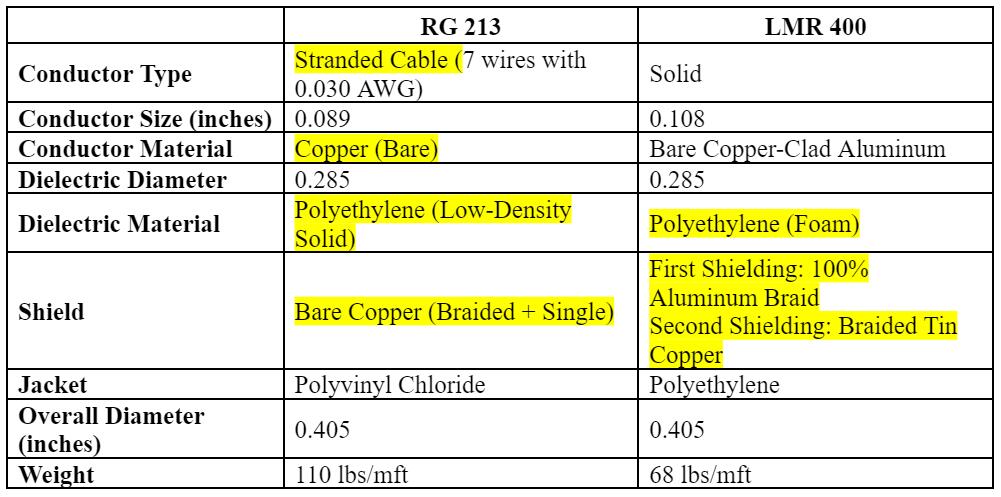VHF radio transmits a radio frequency wave that travels along the cable connecting the radio to the antenna. If a cable without a shield was employed, there is an ineffective transmission of signals reaching the antenna. However, there is less deflection of radiations towards the center conductor with a shielded cable. Coaxial shielding eliminates RF interference from motors, generators, HF radios, and pumps. Especially, Marine VHF applications require a specific type of coax cable. Most fixed-mount maritime VHF radios emit 25 watts, have a 50-ohm output impedance, and operate from 156 to 164 MHz. One of the coax cable types available at marine shops that fulfill these parameters is RG-213. However, you will see electricians comparing the RG 213 vs LMR 400 with it. So, how do you know which one to choose? Let’s find out.
Table of Contents
RG 213 vs LMR 400 Coaxial Cable: Choose according to specs.
You can have clear pictures of LMR400 VS RG213 Coaxial Cable below.

Caption: Inside of an LMR400 Coaxial Cable
Source: https://notsealed.com/

Caption: RG 213 Coaxial Cable inside
Source: https://notsealed.com/
RG 213 vs LMR 400: Specs for Construction
Although RG213 and LMR400 cables are often taken as the same cables, they have a different construction. For example, the conductor material for RG213 is bare copper, but the LMR400 uses bare copper-clad aluminum. Similarly, shielding materials are also different. Let us see more differences between these two options.

RG 213 vs LMR 400: Electric Specifications
As per electrical specs, here are a few differences between the RG213 and LMR 400.

RG 213 vs LMR 400: Attenuation @ Certain Frequencies
Although the electrical specifications of the cables differ, their attenuation at specific frequencies differs. It is due to their handling capacity of different frequencies.
| RG213 Loss (Attenuation dB/100ft) | LMR400 Loss (Attenuation dB/100ft) | |
| 100 MHz | 2.2 | 1.2 |
| 400 MHz | 4.8 | 2.5 |
| 1000 MHz | 8.2 | 4.1 |
As for attenuation, several factors will play a role in signal loss. Moreover, for different conductor types and sizes, the attenuation differs. Thus, the larger the conductor size, the less the signal loss.
RG 213 vs LMR 400: Performance Parameters at 100 Feet and 915MHz
LMR400 is common for GPS, WLAN, WLL, and mobile antennas. You can easily route them through congested places, and it has lower RF cables.
| Attenuation (Nominal) | 3.9 dB/100 ft, 12.9 dB/100 m |
| Avg Power | 0.6 kW |
| Cable Vg | 85.0% |
| Td (Nominal) | 1.2 ns/ft, 3.9 ns/m |
| Capacitance | 23.9 pF/ft, 78.4 pF/m |
| Connector Loss (Typical) | 0.1 dB/pair |
LMR400 Cable Assembly Specs
As in cable assemblies, the LMR400 has the following specs.
| Cable Harness Maximum Insertion Loss | 4.4 dB |
| Wire Harness Run Efficiency | 40.4% |
| Wire Harness Run Time Delay | 119.5 ns |
RG213 cables are commonly found in UHF radio systems as they work best for radio signal transmissions. Moreover, it offers a 50-ohm impedance with higher power handling capabilities. Thus, RG213 is best for higher-power radio industries.
| Attenuation (Nominal) | 6.7 dB/100 ft, 22.0 dB/100 m |
| Avg Power | 0.3 kW |
| Cable Vg | 66.0% |
| Td (Nominal) | 1.5 ns/ft, 5.1 ns/m |
| Capacitance | 30.8 pF/ft, 101.0 pF/m |
| Connector Loss (Typical) | 0.1 dB/pair |
RG213 Cable Assembly Specs
As in cable assemblies, the RG213 has the following performance.
| Cable Harness Maximum Insertion Loss | 7.4 dB |
| Wire Harness Run Efficiency | 21.4% |
| Wire Harness Run Time Delay | 153.9 ns |
LMR400 VS RG213: How Do They Compare?
In terms of their electrical specs, these cables mainly differ in their capacitance, maximum voltage, and frequency.
RG213 can handle 5000V, which is two times as much as LMR400, which can handle only 2500 volts. LMR400 coaxial cables, on the other side, are better than RG213 when it comes to both power handling and loss.
Many things can cause signal attenuation. Most of the time, the attenuation is lower when the conductor is more significant. Since the conductor in LMR400 is bigger than the conductor in RG213, RG213 has more power losses than LMR400.
RG213 coax cable is used in military and commercial applications, such as high-performance electrical and data transmission, radio communications, broadcast, and computer applications.
Moreover, you can use it to feed an antenna when the signal loss is low and high voltages are necessary.
Furthermore, a surface temperature of 75°Celsius works well in places where heat is a problem. Thus RG213 is the same thing in the military as M17/74-RG213.
However, LMR400 is made for jumper assemblies in wireless systems or as a replacement to the RG8/9913 type cable and small antenna feeder runs. It is also suitable for applications that need low-loss RF cable that is easy to route.
Conclusion
RG213 and LMR400 are two types of cables that you can use in VHF radio transmissions. The differences might not be evident in shorter lines, but as you use larger cable assemblies, you will see the changes. Here at Cloom, we offer wiring harnesses, so your connection is made with attention to detail.
